
Coralline algae are red algae in the order Corallinales. They are characterized by a thallus that is hard because of calcareous deposits contained within the cell walls. The colors of these algae are most typically pink, or some other shade of red, but some species can be purple, yellow, blue, white, or gray-green. Coralline algae play an important role in the ecology of coral reefs. Sea urchins, parrot fish, and limpets and chitons feed on coralline algae. In the temperate Mediterranean Sea, coralline algae are the main builders of a typical algal reef, the Coralligène ("coralligenous"). Many are typically encrusting and rock-like, found in marine waters all over the world. Only one species lives in freshwater. Unattached specimens may form relatively smooth compact balls to warty or fruticose thalli.
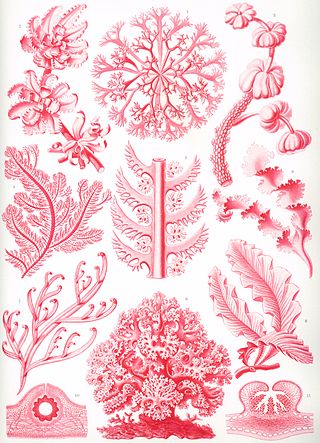
Florideophyceae is a class of exclusively multicellular red algae. They were once thought to be the only algae to bear pit connections, but these have since been found in the filamentous stage of the Bangiaceae. They were also thought only to exhibit apical growth, but there are genera known to grow by intercalary growth. Most, but not all, genera have three phases to the life cycle. In the subclass Nemaliophycidae there are three orders, Balbianiales, Batrachospermales, and Thoreales, which lives exclusively in freshwater.
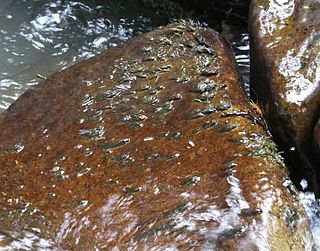
Lemanea is a genus of freshwater red algae, in the order Batrachospermales. Both species are considered to be widespread in the northern hemisphere. Although placed in the Rhodophyta it in fact is green in colour.
Thorea is a genus of fresh water algae in the division Rhodophyta. Thorea is a small alga with filaments up to 200 cm long, dark green in colour and not red as are marine Rhodophyta. The filaments have only as few secondary branches.

Conceptacles are specialized cavities of marine and freshwater algae that contain the reproductive organs. They are situated in the receptacle and open by a small ostiole. Conceptacles are present in Corallinaceae, and Hildenbrandiales, as well as the brown Fucales. In the Fucales there is no haploid phase in the reproductive cycle and therefore no alternation of generations. The thallus is a sporophyte. The diploid plants produce male (antheridia) and female (oogonia) gametangia by meiosis. The gametes are released into the surrounding water; after fusion, the zygote settles and begins growth.

Ochrophytes, also known as heterokontophytes or stramenochromes, are a group of algae. They are the photosynthetic stramenopiles, a group of eukaryotes, organisms with a cell nucleus, characterized by the presence of two unequal flagella, one of which has tripartite hairs called mastigonemes. In particular, they are characterized by photosynthetic organelles or plastids enclosed by four membranes, with membrane-bound compartments called thylakoids organized in piles of three, chlorophyll a and c as their photosynthetic pigments, and additional pigments such as β-carotene and xanthophylls. Ochrophytes are one of the most diverse lineages of eukaryotes, containing ecologically important algae such as brown algae and diatoms. They are classified either as phylum Ochrophyta or Heterokontophyta, or as subphylum Ochrophytina within phylum Gyrista. Their plastids are of red algal origin.
In algal anatomy, a pit connection is a hole in the septum between two algal cells, and is found only in multicellular red algae − specifically in the subphylum Eurhodophytina, except haploid Bangiales. They are often stoppered with proteinaceous "pit plugs". By contrast, many fungi contain septal pores − an unrelated phenomenon.
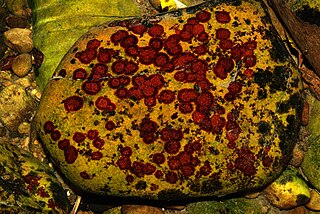
Hildenbrandiales is an order of crustose forms red alga which bear conceptacles and produce secondary pit-connections. They reproduce by vegetative gemmae as well as tetrasporangia, which are produced inside the conceptacles. The way in which the tetraspores are produced is unusual enough to justify the formation of this distinct order. Some members of the order are known from freshwater rivers as well.

Red algae, or Rhodophyta, make up one of the oldest groups of eukaryotic algae. The Rhodophyta comprises one of the largest phyla of algae, containing over 7,000 recognized species within over 900 genera amidst ongoing taxonomic revisions. The majority of species (6,793) are Florideophyceae, and mostly consist of multicellular, marine algae, including many notable seaweeds. Red algae are abundant in marine habitats. Approximately 5% of red algae species occur in freshwater environments, with greater concentrations in warmer areas. Except for two coastal cave dwelling species in the asexual class Cyanidiophyceae, no terrestrial species exist, which may be due to an evolutionary bottleneck in which the last common ancestor lost about 25% of its core genes and much of its evolutionary plasticity.

Hildenbrandia is a genus of thalloid red alga comprising about 26 species. The slow-growing, non-mineralized thalli take a crustose form. Hildenbrandia reproduces by means of conceptacles and produces tetraspores.
Sirodotia Kylin (1912) is a genus of freshwater red alga which was described by Kylin in 1912, and placed in the Batrachospermaceae family.

Batrachospermaceae is a family of fresh water red algae (Rhodophyta). Genera within the Batrachospermaceae generally have a "Lemanea-type" life history with carpospores germinating to produce chantransia. Sporophyte phase with meiosis occurs in an apical cell to produce the gametophyte stage. Pit connections have two pit plug cap layers with the other layer enlarged. This family of freshwater red algae is uniaxial, meaning each filament with a single apical cell. The genera included within Batrachospermaceae are listed in the table below.

Cyanidiophytina is a subdivision of red algae.

Timothy (Tim) John Entwisle, is an Australian botanist, much of whose research work is in phycology (algae). See for example the articles. He was awarded a Ph.D. from La Trobe University in 1986 for work on the taxonomy of Vaucheria.

Naccariaceae is a family of red algae in the order Bonnemaisoniales, with 3 monotypic genera that are found in both the Pacific and Atlantic Oceans.
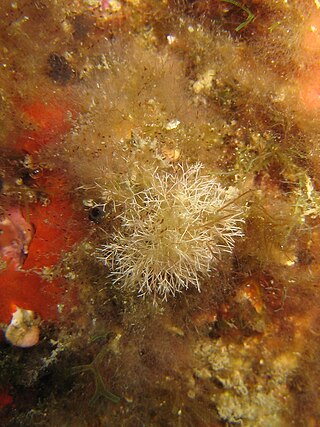
Liagoraceae is a family of red algae (Rhodophyta) in the order Nemaliales. The type genus is LiagoraJ.V.Lamouroux.
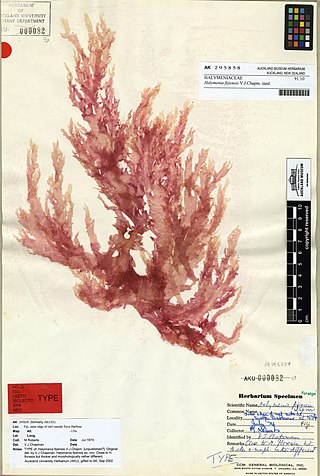
Halymeniales is an order of red algae belonging to the class Florideophyceae and the subclass Rhodymeniophycidae.

Peyssonneliales is a monotypic order of red algae belonging to the class Florideophyceae and the subclass Rhodymeniophycidae. It contains only 1 known family, PeyssonneliaceaeDenizot, M., 1968.
Kathleen "Kay" Margaret Cole was a Canadian phycologist, known as one of the world's leading experts in the cytology of marine algae. In 1998 the Canadian Botanical Society awarded her the George Lawson Medal for lifetime achievement.

Batrachospermum is a genus of red algae from the family Batrachospermaceae. Due to its complex biological life cycle, descriptions of the taxon typically focus on gametophytes, while sporophytes, i.e., carposporophytes, are filamentous structures growing on the gametophyte, on which they depend. Independently living sporophytes have sometimes been described as separate species within the genus Chantransia. Additionally, differences may occur in the descriptions of the genus due to variations in taxonomic approaches, as new taxonomic techniques, as with other algae, result in changes in the assignment of individual species to the genus Batrachospermum. The genus is cosmopolitan, and its representatives are found in freshwater environments, mainly rivers, and less frequently in standing waters. These plants have thalli in the form of gelatinous-coated filaments.















